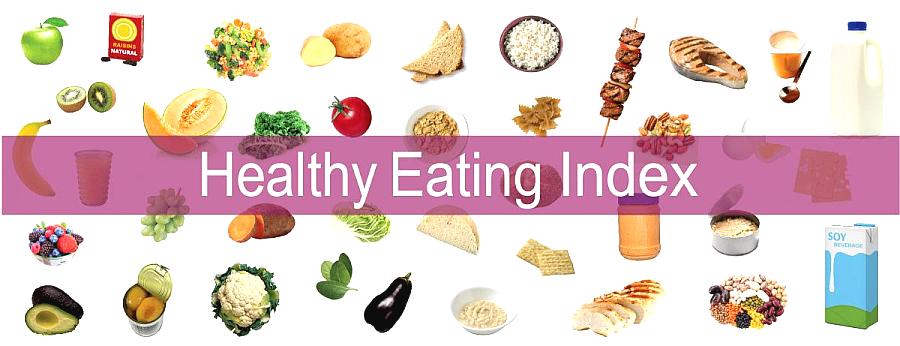

The Healthy Eating Index (HEI) is a tool designed to provide a data-driven understanding of diet quality. The HEI-2020 and the HEI-Toddlers-2020 can be used to see how well the diets of the population in the United States align with the dietary patterns and the key recommendations published in the Dietary Guidelines for Americans, 2020-2025.
Nationally representative survey data called What We Eat in America (WWEIA) the dietary intake interview component of the National Health and Nutrition Examination Survey (NHANES), in which Americans report the types and quantities of foods and beverages they consume in a 24-hour period. These nationally representative dietary intake data are used to calculate average HEI-Toddlers-2020 scores for the population ages 12 through 23 months and average HEI-2020 scores for the population ages 2 years and older. The HEI-Toddlers-2020 takes into account the unique guidance specific to young children ages 12 through 23 months.
An ideal overall HEI score of 100 suggests that the set of foods reported is in line with the Dietary Guidelines for Americans (Dietary Guidelines) key recommendations. The average HEI-Toddlers-2020 score is 63 out of 100 (Lerman, et al, 2023). The average HEI-2020 score in the U.S. population ages 2 and older is 58 out of 100 (Shams-White, et al, 2023). A comparison of HEI scores looking at various age categories showed that HEI-2020 scores varied by age group. Young children up to age 4 years and adults ages 60 and older have the highest average total HEI scores, though average HEI-Toddlers-2020 and HEI-2020 scores indicate that average diet quality across the life span does not align with the Dietary Guidelines.
More information on calculating HEI-Toddlers-2020 and HEI-2020 scores is described on the How the HEI Is Scored page.
The data table below [PDF version] shows how the HEI-2020 total scores and component scores vary across the life span for populations ages two and older. The dietary data came from the WWEIA portion of the 2017-2018 NHANES.
Sources
National Center for Health Statistics, What We Eat in America, National Health and Nutrition Examination Survey (2017–2018). What We Eat in America, National Health and Nutrition Examination Survey (2017–2018)
Healthy Eating Index-2015 Scores - U.S. Department of Agriculture, Center for Nutrition Policy and Promotion, access https://www.fns.usda.gov/CPP/healthy-eating-index-hei.
References
Center for Disease Control and Prevention, National Health and Nutrition Examination Survey Data, 2017-2018. Hyattsville, MD: U.S. Department of Health and Human Services. National Health and Nutrition Examination Survey Data, 2017-2018
U.S. Department of Health and Human Services and U.S. Department of Agriculture. 2015-2020 Dietary Guidelines for Americans. 8th Edition. December 2015. Available at 2015-2020 Dietary Guidelines for Americans. 8th Edition.
Shams-White MM, Pannucci TE, Lerman J, et al. Healthy Eating Index-2020: Review and Update Process to Reflect the Dietary Guidelines for Americans, 2020-2025. J Acad Nutr Diet. Published online May 15, 2023. doi: 10.1016/j.jand.2023.05.015
Suggested Citation
U.S. Department of Agriculture, Food and Nutrition Service, Center for Nutrition Policy and Promotion. 2023. Average Healthy Eating Index-2020 Scores for the U.S. Population - Total Ages 2 and Older and by Age Groups, WWEIA, NHANES 2017-2018
HEI-2015 Scores for Americans
The following links provide HEI scores that indicate the quality of the American diet during various time periods using the HEI-2015. The HEI-2015 was designed to capture the key recommendations of the 2015-2020 Dietary Guidelines for Americans.
- Average Healthy Eating Index-2015 Scores for Children and Adolescents by Age Groups WWEIA, NHANES 2017-2018
- Average Healthy Eating Index-2015 Scores for Adults by Age Groups WWEIA, NHANES 2017-2018
- Average Healthy Eating Index-2015 Scores for Americans by Sex WWEIA, NHANES 2017-2018
- Average Healthy Eating Index-2015 Scores for Americans by Race/Ethnicity Ages 2 Years and Older WWEIA, NHANES 2017-18
- Average Healthy Eating Index-2015 Scores for Americans by Poverty Income Ratio (PIR)
- Average Healthy Eating Index-2015 Scores for Non-Pregnant Non-Lactating, Pregnant, and Lactating Women 20-44 Years WWEIA, NHANES 2013-2018
HEI-2010 Scores for Americans
The following links provide HEI scores that indicate the quality of the American diet during various time periods using the HEI-2010. The HEI-2010 was designed to capture the key recommendations of the Dietary Guidelines for Americans, 2010.
- Average Healthy Eating Index-2010 Scores for Americans by Age Group, WWEIA/NHANES 2011-2012
- Average Healthy Eating Index-2010 Scores for Americans by Age Group, WWEIA/NHANES 2009-2010
- Average Healthy Eating Index-2010 Scores for Americans by Age Group, WWEIA/NHANES 2007-2008
- Average Healthy Eating Index-2010 Scores for Americans by Age Group, WWEIA/NHANES 2005-2006

